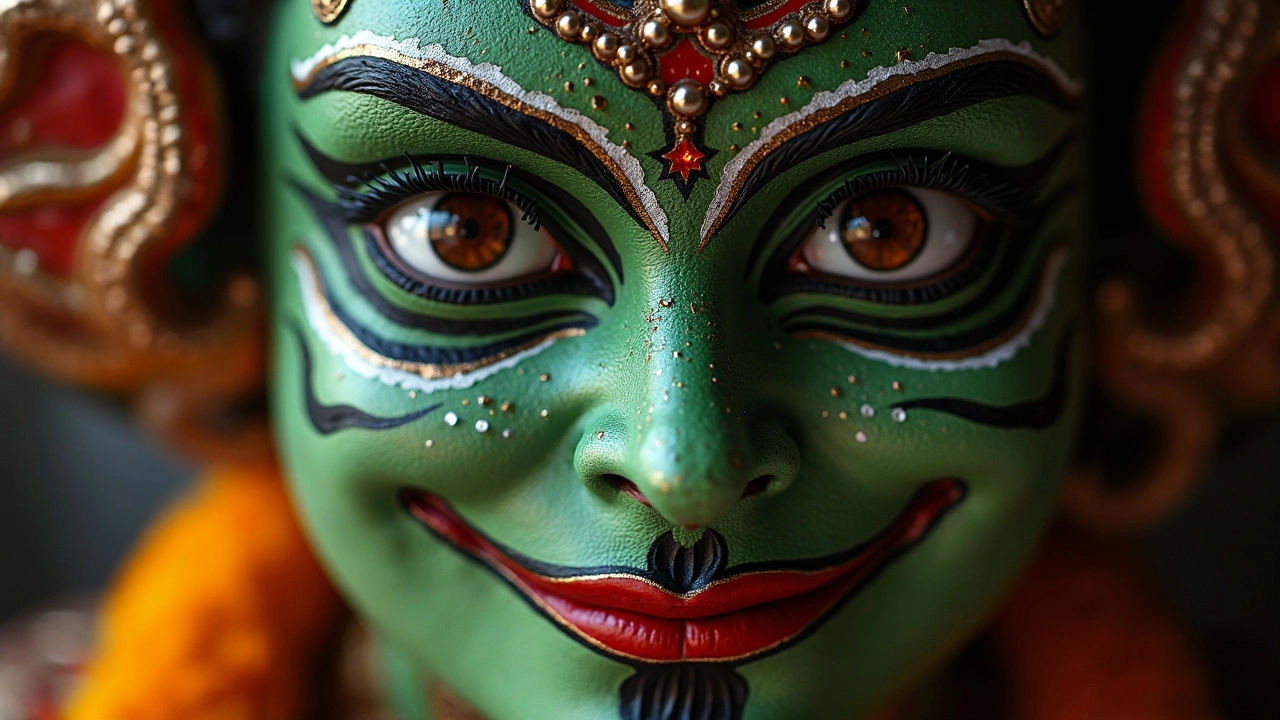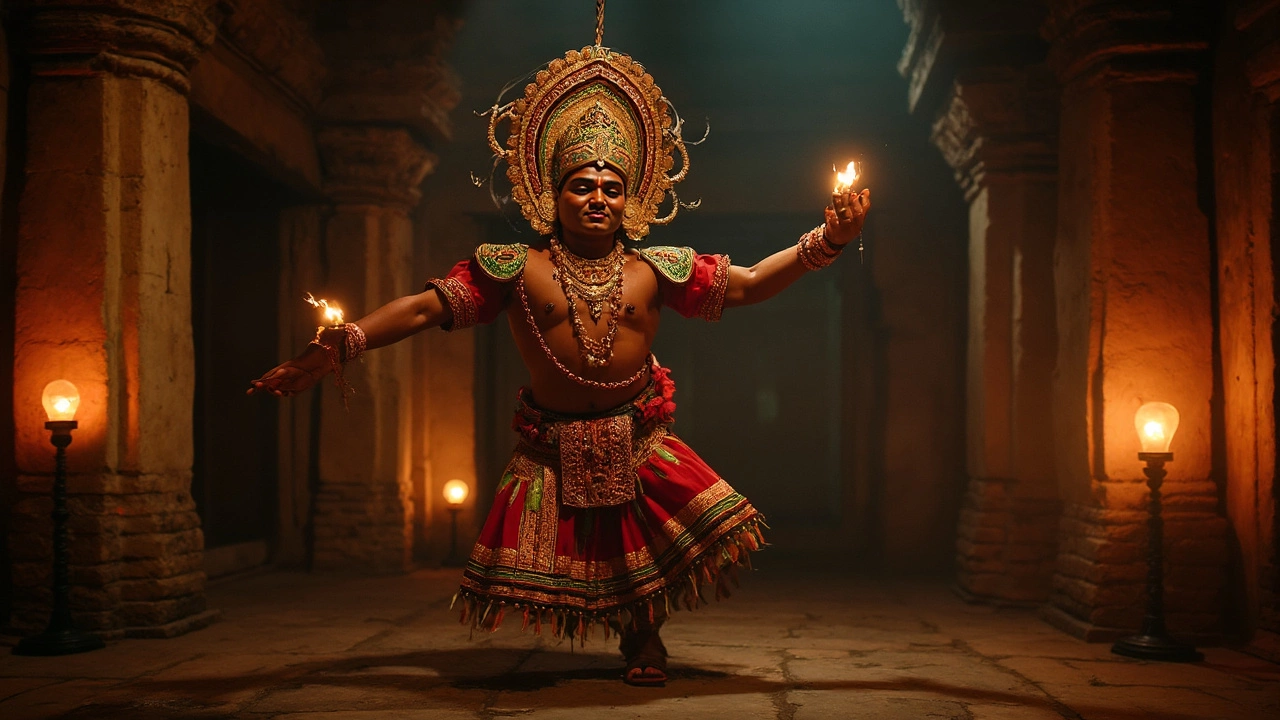When you think about strict dance styles, Kathakali from Kerala, India, should top the list. This isn't just any dance—it's a whole performance art that demands incredible discipline and years of hard work.
So, what's the deal with Kathakali? Imagine a dancer telling epic stories with just their eyes and subtle body movements. Sounds like a magic trick, right? But it's more than that. The dancers wear elaborate costumes and makeup, turning themselves into living artworks.
To become a Kathakali dancer, the training is no joke. Dancers start young, often in special schools, dedicating years to perfecting those precise movements and expressions. It's like learning a new language but with your face and body.
Kathakali isn't just about the dance; it's a deep dive into cultural tales that have been passed down for generations. Next time you're thinking of a dance, remember this—it's an intense journey into the world of art, storytelling, and tradition.
- Understanding Kathakali's Origins
- The Art of Expression in Kathakali
- Training and Discipline Required
- Cultural Significance of Kathakali
Understanding Kathakali's Origins
Let's talk history. Kathakali hails from the picturesque state of Kerala in southern India. This isn't just a dance; it's a traditional performance that dates back to the late 17th century. Yep, it's been around for over 300 years!
Kathakali is thought to have evolved from the earlier forms of dance-theater like Krishnanattam, which tells stories of the Hindu god Krishna. What's interesting is that it wasn't performed in fancy theaters but in temple grounds, during all-night events. Can you imagine pulling an all-nighter for art?
Kathakali came about as a fusion—an artistic expression blending dance, music, acting, and devotion. The rulers of the region, especially a guy named Maharaja Kottarakkara Thampuran, got this started to create a new style. 'Thampuran' sounds like a mouthful, but he's super important in Kathakali's story.
The strict dance turned out to be a way to educate and entertain, depicting stories mostly from two ancient epics, the Mahabharata and the Ramayana. It’s all about using dramatic makeup, costumes, and synchronized movements to bring those centuries-old stories to life. They even use local instruments like chenda and maddalam to set the mood.
Storytelling with Kathakali wasn't just a man’s game, but initially that’s how it started. It wasn't until the 20th century that women joined in regularly. Today, you’ll see both male and female artists perfecting this traditional art form, keeping it alive for future generations.
The Art of Expression in Kathakali
Kathakali is all about storytelling, and it does this mainly through facial expressions known as 'Navarasas,' which translates to the nine emotions. These include love, laughter, sorrow, anger, courage, fear, disgust, wonder, and peace. Mastering these takes years, as each movement is subtle yet powerful.
Kathakali artists are trained to convey complex stories through their expressions and precise hand gestures, called 'mudras.' These gestures are like a sign language that adds another layer to the performance, making it exceptionally unique and detailed.
The Role of Makeup and Costumes
Makeup and costumes in Kathakali are not just for aesthetics; they significantly enhance the storytelling aspect. The color schemes are symbolic. For instance, green denotes piousness and virtue, often used for heroes and divine characters, while red on the face signifies aggression and evil, typically for villainous roles.
Kathakali artists take several hours to apply their makeup, each step precise and crucial in setting up the character they'll portray on stage.
Training the Eyes and Face
An amazing fact about Kathakali training is how seriously they take eye and facial muscle exercises. Artists engage in specific drills to build muscle control in their eyes and face, allowing them to switch emotions in an instant, a hallmark of the art form. It's like a workout session but purely for emotions.
| Facial Expression | Emotion |
|---|---|
| Slanting the eyebrows | Anger |
| Widening eyes | Fear |
| Lip movements | Sorrow |
Every moment on the stage translates into a vivid story unfolding right before your eyes, making Kathakali a dance that's as much a visual spectacle as it is an emotional journey.

Training and Discipline Required
Becoming a Kathakali dancer isn't just about shaking a leg or two; it's a path paved with immense dedication and rigorous training. The journey usually kicks off at a young age in Gurukulas—traditional training schools that focus on developing both body and mind.
Starting Young
Most students begin their training around the age of 10, giving them ample time to master the basic techniques and build the stamina needed for this strict dance. The training is extensive, sometimes stretching over eight to ten years. It’s not for the faint-hearted!
The Daily Grind
When it comes to the daily routine, it's a mix of physical exercises, practicing dance steps, and learning intricate facial expressions. Let's not forget the long hours spent on learning dialogues and understanding the mythological stories that the dance narrates.
The Role of Discipline
When you're aiming to excel in one of the most strict dance forms, discipline becomes your best friend. Students often adhere to a demanding schedule, waking up at the crack of dawn for practice and staying up late to perfect their techniques.
Skills in Focus
- Choreographed Movements: Every movement is meticulously choreographed, down to the precise finger positioning.
- Facial Expressions: Known as Navarasas (nine emotions), mastering these expressions is vital.
- Body Flexibility: Flexibility exercises are crucial to gracefully perform those demanding dance moves.
| Training Aspect | Hours Spent (Daily) |
|---|---|
| Body Movements | 3-4 hours |
| Facial Expressions | 2 hours |
| Storytelling | 1-2 hours |
All this training and discipline lead to one goal: turning dancers into not just performers, but storytellers who bring ancient tales to life with awe-inspiring precision and artistry.
Cultural Significance of Kathakali
Kathakali isn't just a dance; it's a cultural treasure of Kerala, weaving together myths, legends, and traditions through its intricate performances. With roots going back to the 17th century, Kathakali has played a huge part in preserving the rich history and storytelling traditions of India.
When you dive into a Kathakali performance, you're watching more than just impressive moves. You're witnessing the retelling of epic tales like the Mahabharata and Ramayana, which are significant religious texts in Hindu culture. Through expressions and gestures, the dancers bring gods, demons, and heroes to life, creating a visual feast that captures the imagination.
The Role of Kathakali in Modern Culture
Even today, Kathakali continues to be a symbol of pride in Kerala. Tourists flock to the region, eager to catch a live performance. Schools in Kerala and beyond teach young students this traditional art, ensuring it stays alive for future generations.
Despite its ancient origins, Kathakali has adapted over time. While it still respects traditional stories, some performances blend modern themes, connecting with younger audiences. Hence, Kathakali is not just about preserving the past; it’s about keeping the culture vibrant and relevant.
Community and Religious Influence
Kathakali performances often coincide with religious festivals, acting as a form of devotion and worship. Temples host these performances, with audiences joining in the spiritual experience. The community aspect is strong, emphasizing the dance’s role in religious and cultural unity.
In modern day Kerala, Kathakali is also a proud tourist attraction. People from all over the world come to witness this dazzling blend of art and culture. This international interest has helped spread awareness of Kathakali, increasing appreciation for this traditional dance outside India.
